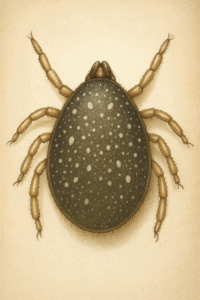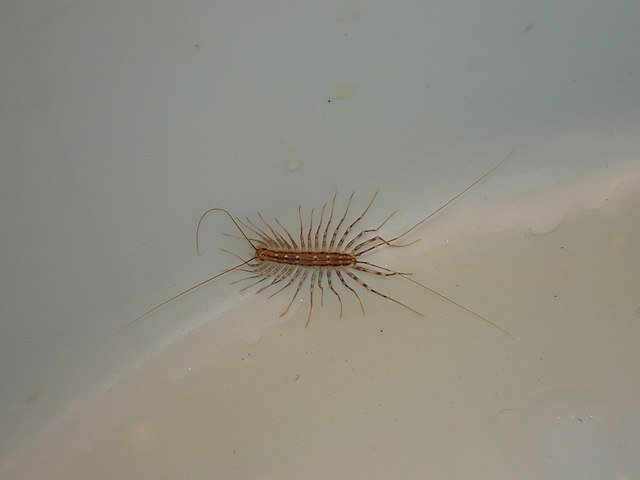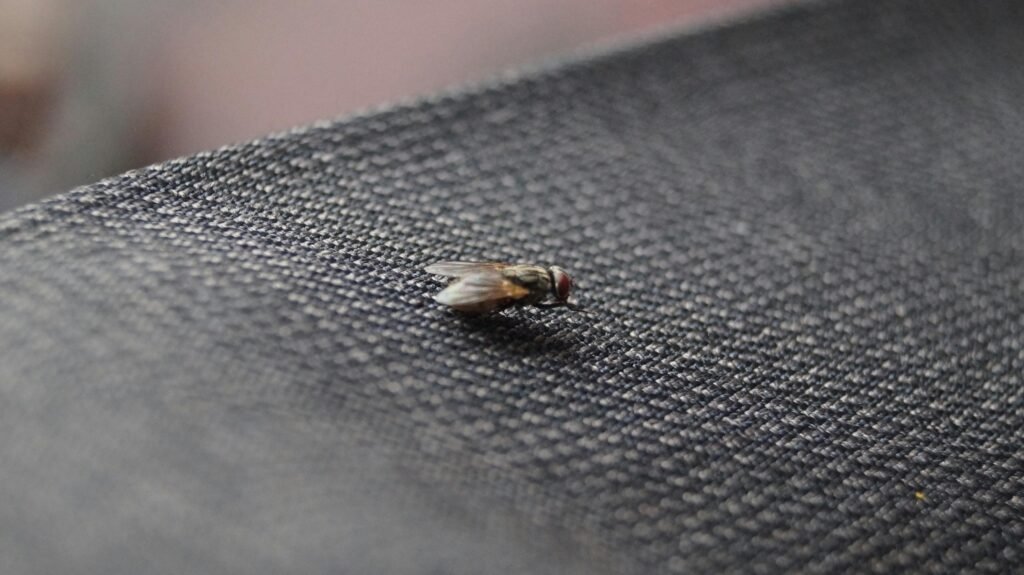Pigeon Ticks (Argas reflexus): Identification, Risks, and Control
 If you’ve ever noticed small, flat, reddish-brown ticks crawling near windows, ceilings, or behind curtains after pigeons have been removed, you’re probably dealing with pigeon ticks (Argas reflexus). These parasites are specialized to feed on pigeons but quickly turn to humans when their main hosts disappear.
If you’ve ever noticed small, flat, reddish-brown ticks crawling near windows, ceilings, or behind curtains after pigeons have been removed, you’re probably dealing with pigeon ticks (Argas reflexus). These parasites are specialized to feed on pigeons but quickly turn to humans when their main hosts disappear.
As a pest control professional, I’ve seen severe infestations in attics, apartment buildings, and churches where pigeons nest. The biggest problem? These ticks can survive for years without feeding and remain hidden in cracks, making control challenging once they’re established.
Identification
The pigeon tick (Argas reflexus) belongs to the Argasidae, or soft ticks — a group different from the hard ticks (Ixodidae) that most people know from pets or the countryside.
Key identification features include:
Oval, flattened body without a visible hard shield (scutum).
Size: 4–10 mm depending on the feeding stage.
Color: yellowish to dark brown.
Mouthparts are hidden on the underside.
Moves fast compared to typical hard ticks.
Unlike bed bugs, pigeon ticks have a leathery surface and do not leave dark fecal spots. Under magnification, they show wrinkled skin with small punctures and fine grooves.
Biology and Ecology
Argas reflexus spends most of its life hidden in cracks near pigeon nesting sites — roof beams, ventilation ducts, ledges, or window sills.
Its life cycle includes egg → larva → several nymph stages → adult, and depending on temperature and humidity, development may take months or years.
These ticks feed only briefly — usually at night — and return to their hiding spots after sucking blood.
Adults can live up to 10 years, and astonishingly, survive 3–5 years without feeding.
They prefer:
Warm, dry environments (attics, lofts, unused upper floors).
Buildings where pigeons nest for several years.
After pigeon removal, ticks wander in search of new hosts — often humans or pets — and may spread through walls, electrical ducts, or ceilings.
Global Distribution
The pigeon tick is native to Europe, but has been reported in North Africa, the Middle East, and parts of Central Asia.
In recent years, due to urban pigeon populations, cases have appeared in North America as well, particularly in old buildings converted into apartments.
It is more common in:
Southern and Central Europe (Greece, Italy, Germany, France).
Old city centers with heavy pigeon presence.
Warehouses, churches, and schools that were once bird roosting sites.
Health Risks and Damage
While Argas reflexus prefers pigeons, it can bite humans, cats, and dogs. The bites are painful and may cause:
Allergic reactions and dermatitis.
In rare cases, anaphylactic shock due to allergic sensitivity to tick saliva.
Sleep disturbance from repeated night bites.
There’s also growing concern about pathogen transmission. Studies have found that pigeon ticks can carry Borrelia species (the bacteria behind Lyme disease) and Rickettsia, though confirmed human cases remain rare.
In buildings, heavy infestations cause:
Fear and discomfort among tenants.
Complaints due to crawling ticks on walls and ceilings.
Risk of reinfestation months after pigeon removal.
Signs of Infestation
Early detection is difficult. You rarely see the ticks during the day, and there is no specific odor like in bed bug infestations.
Typical signs include:
Crawling ticks on walls or near windows, especially after pigeons are removed.
Dead pigeons or nests in roof areas.
Tick bites on exposed body parts (neck, arms, legs).
Noise at night (ticks crawling or falling from ceilings).
Using a flashlight to inspect pigeon roosts or cracks near attics often reveals clusters of soft, brown ticks hidden in dust or pigeon droppings.
Control Methods
Controlling Argas reflexus is not as simple as removing pigeons. The ticks can survive long after their hosts are gone. I’ve seen infestations reappear months after full pigeon exclusion, simply because the eggs remained hidden inside crevices.
Step 1: Eliminate the source
Remove all pigeon nests and droppings.
Seal every possible entry point — roof vents, broken tiles, ledges.
Install bird spikes or netting to prevent re-nesting.
Step 2: Mechanical cleaning
Vacuum and scrape droppings, feathers, and nesting debris.
Dispose of waste safely — use gloves and masks (droppings may contain Chlamydia psittaci bacteria).
Step 3: Chemical control
Apply residual insecticides (such as pyrethroids or carbamates) to cracks, crevices, beams, and window frames.
For deep crevices, aerosol formulations or ULV (ultra-low volume) treatments can reach hidden ticks.
In severe infestations, thermal fogging is used to penetrate voids.
Step 4: Monitoring and follow-up
Inspect again after 2–3 weeks.
Apply a second treatment if ticks are still active.
Avoid cleaning treated surfaces too early — residual insecticides need time.
Advanced Approaches
For professional use, insecticidal dusts containing silica gel or diatomaceous earth can desiccate hidden ticks.
These are useful in sensitive environments like churches or attics where liquid sprays are not ideal.
Integrated Pest Management (IPM) is essential:
Combine physical exclusion, environmental control, and chemical treatments.
Maintain low humidity and good ventilation — ticks prefer dry but stagnant air.
Educate building managers to report pigeon activity early.
Cultural and Historical Context
Pigeon ticks have been known for centuries. In older European literature, they were called the “house plague of the pigeoner”, since they attacked people who worked in pigeon lofts.
In some regions of Germany and Austria, people referred to them as Taubenzecken, feared for causing mysterious “night fevers” long before tick-borne diseases were scientifically understood.
Urban growth and pigeon overpopulation have revived the problem in many cities today. Once considered a rare pest, Argas reflexus is now a common issue for pest control companies dealing with old buildings.
FAQ
1. Can pigeon ticks bite humans?
Yes. When pigeons are removed, these ticks search for other hosts, including humans. Bites are painful and may cause allergic reactions.
2. How long can pigeon ticks live without feeding?
Adults can survive up to 5 years without a blood meal, making them extremely persistent pests.
3. Are pigeon ticks dangerous?
They can cause strong allergic reactions and occasionally transmit bacteria such as Borrelia. Fatalities are extremely rare, but medical attention is recommended after multiple bites.
4. Do pesticides kill pigeon ticks immediately?
No. Soft ticks are resilient and often hide deep in cracks. Multiple treatments may be necessary.
5. What’s the difference between pigeon ticks and bed bugs?
Pigeon ticks are arachnids (related to spiders), while bed bugs are insects. Ticks are rounder, softer, and feed for shorter periods.
6. How can I prevent pigeon ticks in my building?
The best prevention is to stop pigeons from nesting. Regular cleaning and structural maintenance prevent both pigeons and ticks from returning.
Final Thoughts
Pigeon ticks (Argas reflexus) are one of those pests that people rarely think about — until the problem literally starts crawling down the wall.
They’re not as visible as bed bugs, not as fast as cockroaches, but they are much more resilient.
The most common mistake I see from homeowners and facility managers is assuming that removing pigeons solves the issue. It doesn’t. These ticks stay behind for years, waiting.
A proper control plan means:
Full pigeon exclusion,
Deep cleaning,
Targeted insecticide application,
And monitoring for re-emergence.
If you live in an old building or near a pigeon-infested roof, stay alert. A few small preventive actions now can save you from months of recurring infestations later.
Disclaimer
This article is for informational purposes only. Pest control laws and approved chemicals vary by country. For best results and legal safety, we strongly recommend contacting a licensed pest control professional in your local area. Always make sure that the pest control technician is properly certified or licensed, depending on your country’s regulations. It’s important to confirm that they only use approved products and apply them exactly as instructed on the product label. In most places in Europe, UK, or USA, following label directions is not just best practice—it’s the law.
Author
Nasos Iliopoulos
BSc Agronomist & Certified Pest Control Expert
Scientific Director, Advance Services (Athens, Greece)
Licensed Pest Control Business – Ministry of Rural Development & Food (GR)
References
Estrada-Peña, A., & Jongejan, F. (1999). Ticks feeding on humans: a review of records on human-biting Ixodidae and Argasidae in Europe. Parasitology Research.
Hornok, S., et al. (2016). Human-biting soft ticks (Argasidae) in Europe: epidemiological significance and control. Vector-Borne and Zoonotic Diseases.
Buczek, A. (2000). Biology and medical importance of Argas reflexus (Fabricius, 1794). Wiadomości Parazytologiczne.
Salinas, L. J., et al. (2010). Urban infestation and control of pigeon ticks (Argas reflexus) in buildings. Journal of Urban Pest Management.


